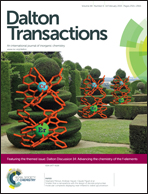Synthesis, characterization and magnetism of metal–organic compounds: role of the positions of the coordinating groups of a meso-flexible ligand in placing anisotropy to exhibit spin-canting behaviour†‡
Abstract
In continuation of our recent investigation on flexible ligands, three new metal–organic coordination framework containing compounds, formulated as {Co2(L1)2(px3ampy)2}n·npx3ampy (1), {Co(L2)(px3ampy)0.5}n (2) and {Co2(L3) (px3ampy)2(H2O)}n·3nH2O (3) have been synthesized using three structurally different meso-flexible polycarboxylate ligands, H2L1 (4,4′-methylenebis-(oxy)dibenzoic acid), H2L2 (3,3′-methylenebis-(oxy)dibenzoic acid) and H4L3 (5,5′-methylene-bis(oxy)diisophthalic acid) bearing the flexible spacer in the middle of the skeleton, along with a long flexible pyridyl ligand px3ampy (1,4-bis(3-pyridylaminomethyl)benzene). Compounds 1–3 have been characterized by single crystal X-ray diffraction analysis, IR spectroscopy and thermogravimetric (TG) studies including elemental analysis. The crystal structure determinations reveal that compound 1 has a 1D ladder-like structure and compounds 2 and 3 are characterized by 3D frameworks. Compound 2 possesses a tiling of a snz net and compound 3 has a 3D interpenetrated motif with a (4,4) connecting 2-nodal net. The variable temperature magnetic susceptibility measurements demonstrate the dominating antiferromagnetic nature of all three title compounds; interestingly, however, compounds 2 and 3 exhibit ferromagnetic interactions due to the uncompensated magnetic moment of the system at low temperatures. Compound 2 illustrates the occurrence of spin canted antiferromagnetic ordering at Tc ≈ 25 K with a coercive field (Hc) of 900 Oe at 10 K due to the inclusion of magnetic anisotropy caused by the twisting of the concerned ligand skeleton. Compound 3 shows comparatively weak ferromagnetic ordering with Tc ≈ 9.5 K, for which weak magnetic anisotropy is present because of two different coordination environments (octahedral and tetrahedral) between two cobalt centers. A structure–function relationship has been described based on the position of the coordinating groups with respect to the flexible center of the ligand skeleton as well as the coordination angle between the ligand and the metal ion.


 Please wait while we load your content...
Please wait while we load your content...